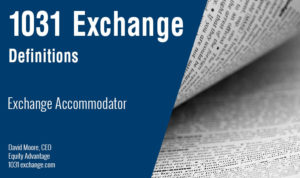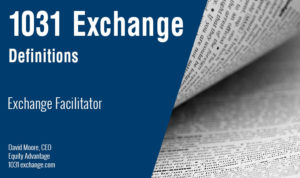David and Tom Moore—known industrywide as the 1031 Exchange Bros—take a hard look at the promises and pitfalls of relying solely on artificial intelligence for 1031 Exchange guidance. With more than three decades in the Exchange business and thousands of client interactions between them, David and Tom bring practical experience to an increasingly theoretical conversation: AI can answer many questions, but it rarely knows the right questions to ask.
Why AI Is Useful—and Why It Falls Short
AI has a place in real estate. It can distill rules, summarize procedures, and provide quick comparisons. But David and Tom stress a crucial limitation: AI generalizes. For complex tax-deferral strategies like a 1031 Exchange, the differences between a safe, value-adding Exchange and a risky one often hinge on client-specific facts that AI cannot reliably infer.
“AI can deliver quick answers, but it does not know the right questions to ask,” David and Tom explain. “And if you don’t ask the right questions, you’re likely to get an answer that will cost you.”
That simple observation drives the rest of their analysis. Far too often, they say, people ask AI for fees, timelines, or checklists and then treat the output as a substitute for tailored advice. The result: missed opportunities, unnecessary risk, and sometimes failed transactions.
The Big Issue: Not Knowing the Right Questions to Ask
Experience matters because experienced practitioners know which facts matter. David and Tom point to several recurring examples:
- Intended use and ownership structure of replacement property
- Whether a client intends to pull cash (boot) and how that affects tax exposure
- Prior exchanges, gifts, inheritances, or involuntary conversions that change basis
- Timing constraints for reverse, improvement, or delayed Exchanges
AI can regurgitate rules like the 180-day limit for reverse Exchanges or the RevProc safe harbors, but it will not reliably evaluate whether a non-safe-harbor structure is an acceptable risk for a particular client. Only a conversation with seasoned specialists uncovers those nuances.
Safe Harbor vs Non-Safe Harbor Exchanges: The Gray Area
David and Tom explain the difference between safe harbor rules and non-safe-harbor approaches, especially in the context of reverse Exchanges and improvement Exchanges. A few points they make:
- Safe harbor guidance (for example, RevProc 2000-37) sets explicit timelines and procedures. AI will default to these rules as the “correct” approach.
- Non-safe-harbor transactions have always been possible, but they require deliberate documentation, allocation of burdens and benefits, and an acceptance of additional legal risk.
- There are situations where a non-safe-harbor approach is sensible—build-to-suit deals and some improvement Exchanges among them—if the client understands and accepts the tradeoffs.
In short, AI is likely to default to the conservative, rulebook answer. That is often appropriate, but not always optimal for an investor with a specific appetite for risk and return.
Fees, Value, and the Risks of “Free”
“You get what you pay for” is a refrain David and Tom repeat throughout the discussion. Fee pressures in the Exchange world have pushed many traditional costs downward, but that compression raises questions about competence, responsibility, and where the risk sits.
Key considerations:
- Exchange fees historically reflected a mix of administrative burden, custody of funds, regulatory compliance, and professional judgment. While headline fees may seem small on a settlement statement, the responsibility behind them is significant.
- Ultra-low-cost or AI-only providers may omit essential services: document reviews, secure custody practices, or nuanced structuring conversations.
- Clients should ask not just “How much?” but “What am I getting for this fee?” and “Who will hold my funds and how are they secured?”
David and Tom recount situations where inexperienced attorneys or new facilitators charged more but lacked practical Exchange expertise, and where conversely some old-timers charge less than market value. The lesson: fee alone is not the right metric. The client’s exposure, the size of the deal, and custody/security practices matter much more.
Referral Fees and Conflicts of Interest
Another red flag discussed at length is the practice of paying referral fees to brokers to steer clients to a particular Exchange provider. David and Tom stress the ethical and practical concerns:
- Paying brokers to send volume to a new or inexperienced Exchange provider can create perverse incentives and elevate client risk.
- Brokers who accept referral payments multiply risk—how many clients are they pushing through an unvetted provider to earn small referral checks?
- Clients should ask their broker why they recommend a particular facilitator, and brokers should prefer long-term credibility over short-term referral revenue.
Equity Advantage’s policy is simple: they do not pay referral fees. Instead, they focus on making referring brokers look good by protecting their clients and delivering reliable service.
Security, Custody, and Handling Large Transactions
Handling funds securely is core to the Exchange business. David and Tom described a recent example: a roughly $100 million transaction where the client insisted on holding funds a way the facilitators were not comfortable with.
Lessons from that story:
- Large accounts require sophisticated custody, qualified escrow arrangements, and security measures that inexperienced providers may not offer.
- Sometimes the client will prefer another provider or an attorney, even if the Exchange specialist recommends otherwise. The client must weigh convenience against risk.
- Experienced facilitators will typically insist on structures that protect client funds and limit constructive receipt exposure.
Qualified Money: IRAs, 401(k)s, and Patient Capital
One of the most under-discussed opportunities for real estate investors is the role of qualified retirement funds in real estate investing. David and Tom spotlight several advantages:
- IRA and 401(k) funds are often more patient capital. Owners cannot access these funds without penalty until retirement age, so these dollars are generally less price-sensitive and more willing to accept longer investment horizons.
- Qualified money can invest in a wider array of structures than a 1031 Exchange requires, including funds, partnership interests, and loans, giving sponsors and developers more flexible sources of capital.
- For mom-and-pop investors looking to preserve cash flow, Delaware Statutory Trusts (DSTs) often make sense because they can provide consistent distributions immediately after purchase.
Qualified money is not a magic bullet, but for many developers and sponsors it is a strategic source of capital that is worth cultivating.
Basis, Depreciation, and Why AI Can’t Calculate Your Tax Picture
One of the most technical and consequential aspects of Exchange planning is basis calculation. David and Tom emphasize that AI cannot reliably compute whether an investor has tax liability, because the inputs are often unknown or misinterpreted by the investor:
- Basis is purchase price plus capital improvements minus depreciation. But purchase price is not always straightforward, and capital improvements require proper allocation and documentation.
- Prior gifts, inheritances, involuntary conversions, cost segregation studies, and past depreciation elections all affect basis in ways that AI can only approximate.
- Most investors do not know their basis, and tax advisors need to reconstruct history to provide accurate tax exposure estimates.
In practice, AI can run a “capital gains calculator” and spit out a number, but it cannot account for missing or nuanced facts. That is why David and Tom insist on a human review with clients and their tax advisors before electing to complete or skip an Exchange.
Cash-Out Refinances: Timing and Intent
Pulling cash out of a property before a sale is a classic minefield. David and Tom give practical guidance:
- Refinancing in anticipation of a sale can be viewed as part of the sale transaction and may attract IRS scrutiny under a step transaction theory. That can convert supposed Exchange funds into taxable proceeds.
- If a refinance is done well before a contemplated sale and for legitimate reasons (e.g., loan maturity, necessary improvements), it is less likely to be questioned.
- Reverse Exchanges can legitimately use pre-sale refinancing when all equity is tracked forward into the replacement property and the “napkin test” (tracking value and equity) is satisfied.
The bottom line: intent matters. Document motives, timing, and the flow of funds. If a client wants to cash out some equity, the team should plan the transaction and the tax timing together with the client’s CPA.
Practical Advice for Investors, Brokers, and Advisors
Based on their decades of experience, David and Tom offer practical takeaways:
- Use AI as a research tool, not a decision-maker. Let AI summarize rules, but validate those summaries with experienced Exchange professionals and tax advisors.
- Ask not just how much a facilitator charges, but what services, custody practices, and experience back that fee.
- Be cautious of referral-driven recommendations. Ask why your broker prefers a particular provider and whether that choice lines up with your long-term interests.
- When working with qualified money like IRAs or 401(k) funds, consider the different timing and liquidity profile that can make these sources ideal for some investments.
- Document intent and the movement of funds. If the IRS ever queries an Exchange, clear documentation and the right legal steps make all the difference.
FAQ
Can AI handle a 1031 Exchange from start to finish?
No. AI can provide general guidance and summarize regulations, but it cannot replace the human conversations, fact-finding, fund custody, and judgment needed to structure and close complex Exchanges.
Are reverse Exchanges always limited to 180 days?
The safe harbor guidance often references a 180-day window, and AI will usually default to that. But experienced practitioners sometimes structure non-safe-harbor reverse Exchanges or other approaches when clients accept additional documented risk. Those structures require careful legal and tax analysis.
Is paying a low fee for an Exchange a good idea?
Not necessarily. Low fees can mean missing services or weak custody. Look beyond price: evaluate the provider’s experience, how funds are held, and whether they will proactively identify issues that could convert deferral into tax liability.
When is a cash-out refinance before a sale safe?
Refinances done long before listing, or for legitimate business reasons such as loan maturity or property improvements, are less risky. Doing a refinance in anticipation of an imminent sale may be treated as part of the sale and attract IRS scrutiny.
How should investors use qualified retirement funds in real estate?
Qualified money can be an excellent, patient source of capital for acquisitions, funds, and lending. Investors should work with custodians and advisors experienced in self-directed retirement investing to avoid unrelated business taxable income and other pitfalls.
The Bottom Line: Experience Over Algorithms
David and Tom Moore, the 1031 Exchange Bros from Equity Advantage 1031 Exchange, make a clear case: AI is a valuable tool for quick answers and broad education, but it is not a substitute for real-world experience, careful fact-finding, and professional judgment. For Exchange decisions that affect retirement, tax exposure, and long-term financial outcomes, human expertise remains indispensable.
Clients and advisors should use AI to complement—not replace—the conversations that reveal intent, reconstruct basis, safeguard funds, and align strategy with long-term goals. David and Tom final advice for investors, “You can do what you don’t know,” but you will be far better off when you know what you are doing before you take the plunge into a 1031 Exchange.
For more resources and personalized guidance, visit 1031Exchange.com or reach out to Equity Advantage 1031 Exchange to discuss specific situations and plan Exchange strategy with experienced professionals.
The Guys With All The Answers…
 David and Thomas Moore, the co-founders of Equity Advantage & IRA Advantage
David and Thomas Moore, the co-founders of Equity Advantage & IRA Advantage
Whether working through a 1031 Exchange with Equity Advantage, acquiring real estate with an IRA through IRA Advantage or listing investment property through our Post 1031 property listing site, we are here to help Investors get where they want to be. Call them today! 503-635-1031.









